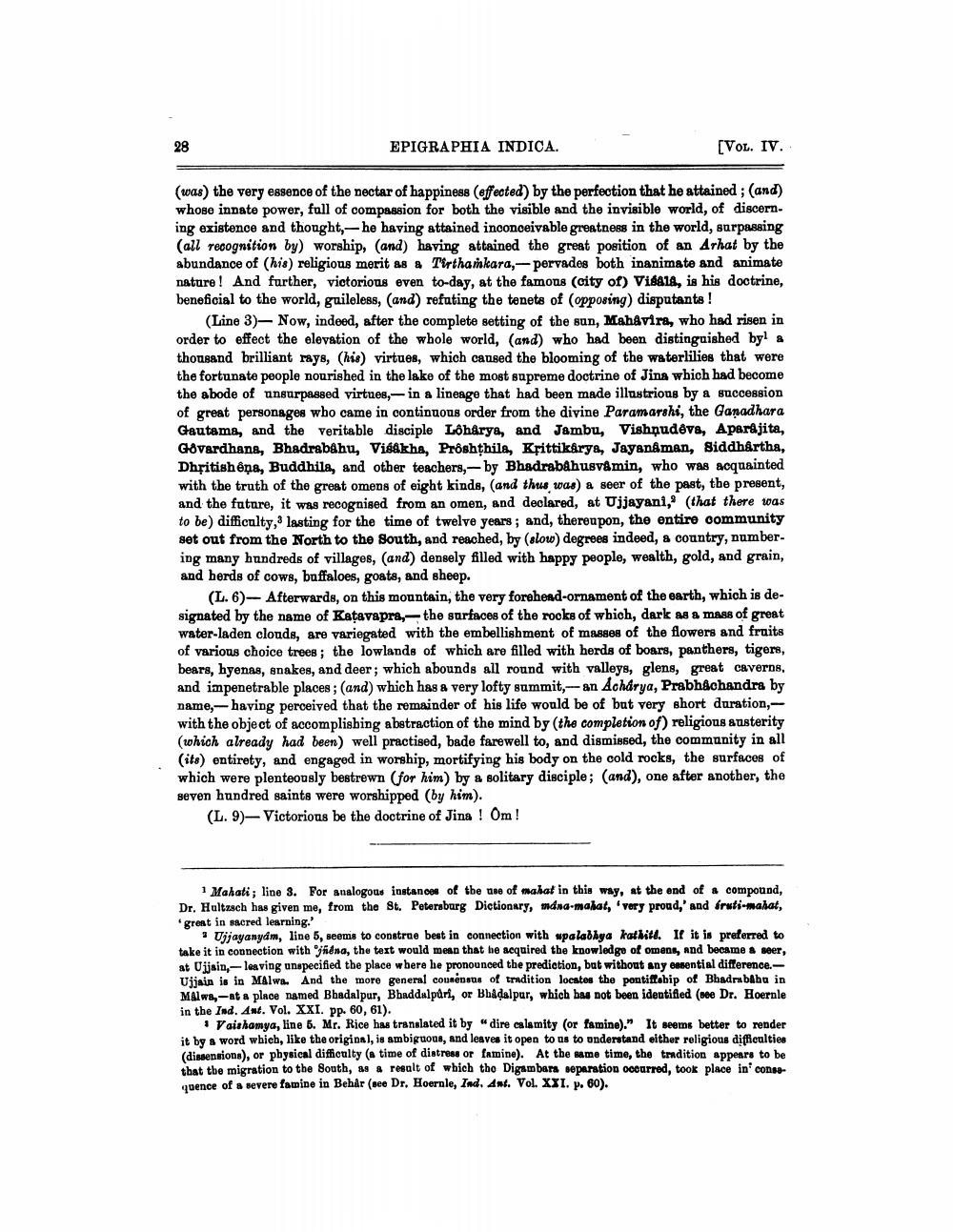________________
EPIGRAPHIA INDICA.
[VOL. IV.
(was) the very essence of the nectar of happiness (effected by the perfection that he attained ; (and) whose innate power, full of compassion for both the visible and the invisible world, of discern. ing existence and thought -- he having attained inconceivable greatness in the world, surpassing (all recognition by) worship, (and) having attained the great position of an Arhat by the abundance of (his) religious merit as a Tirthankara, -pervades both inanimate and animate nature ! And further, victorious even to-day, at the famous (city of) Vidal, is his doctrine, beneficial to the world, gaileless, (and) refuting the tenets of (opposing) disputants !
(Line 3)- Now, indeed, after the complete setting of the sun, Mahavira, who had risen in order to effect the elevation of the whole world, (and) who had been distinguished by a thousand brilliant rays, (his) virtues, which cansed the blooming of the waterlilies that were the fortunate people nourished in the lake of the most supreme doctrine of Jina which had become the abode of unsurpassed virtues,- in a lineage that had been made illustrions by a succession of great personages who came in continuous order from the divine Paramarshi, the Ganadhara Gautama, and the veritable disciple Lôharya, and Jambu, Vishnudova, Aparajita, Govardhana, Bhadrabahu, Visakha, Proshthila, Kfittikarya, Jayanaman, Siddhartha, Dhritish êŋa, Buddhila, and other teachers, - by Bhadrabahusvåmin, who was acquainted with the truth of the great omens of eight kinds, (and thus was) a seer of the past, the present, and the future, it was recognised from an omen, and declared, at Ujjayani, (that there was to be) difficulty, lasting for the time of twelve years; and, thereupon, the entire community set out from the North to the South, and reached, by (slow) degrees indeed, a country, numbering many hundreds of villages, (and) densely filled with happy people, wealth, gold, and grain, and herds of cows, buffaloes, goats, and sheep.
(L. 6)- Afterwards, on this mountain, the very forehead-ornament of the earth, which is designated by the name of Katavapra, the surfaces of the rocks of which, dark as a mass of great water-laden clouds, are variegated with the embellishment of masses of the flowers and fruits of various choice trees; the lowlands of which are filled with herds of boars, panthers, tigers, bears, hyenas, snakes, and deer; which abounds all round with valleys, glens, great caverns, and impenetrable places; (and) which has a very lofty summit,- an Acharya, Prabhachandra by name,--having perceived that the remainder of his life would be of but very short duration, with the object of accomplishing abstraction of the mind by the completion of) religious austerity (which already had been) well practised, bade farewell to, and dismissed, the community in all (its) entirety, and engaged in worship, mortifying his body on the cold rocks, the surfaces of which were plenteously bestrewn (for him) by a solitary disciple; (and), one after another, the seven hundred saints were worshipped (by him).
(L. 9)- Victorious be the doctrine of Jina ! Om!
1 Mahati; line 3. For analogous instances of the use of mahat in this way, at the end of compound, Dr. Hultzsch has given me, from the St. Petersburg Dictionary, edna-mahat, very proud,' and fruti-mahat, 'great in sacred learning.'
Ujjayanydm, line 5, seems to construe best in connection with wpalabhga hathite. If it is preferred to take it in connection with fina, the text would mean that he acquired the knowledge of omens, and became a seer, at Ujjain, leaving unspecified the place where he pronounced the prediction, but without any essential difference. - Ujjain is in Malwa. And the more general couněnsus of tradition locates the pontiftship of Bhadrababu in MAlwa, at a place named Bhadalpur, Bhaddulpuri, or Bhadalpur, which has not been identified (e Dr. Hoernle in the Ind. Ant. Vol. XXI. PP. 60, 61).
Vaishamya, line 5. Mr. Rice has translated it by "dire calamity (or famine).” It seems better to render it by a word which, like the original, is ambiguous, and leaves it open to us to understand either religious difficulties (dissensions), or physical difficulty (a time of distress or famine). At the same time, the tradition appears to be that tbe migration to the South, as a result of which tho Digambar separation occurred, took place in consequence of a severe famine in Behår (see Dr. Hoernle, Ind. Ant. Vol. XXI. p. 60).




